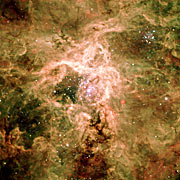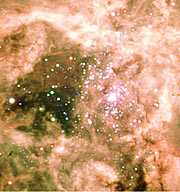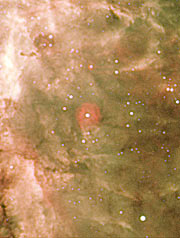Pressmeddelande
Cosmic Spider is Good Mother
VLT FORS Image of the Inner Parts of the Tarantula Nebula
7 april 2006
Hanging above the Large Magellanic Cloud (LMC) - one of our closest galaxies - in what some describe as a frightening sight, the Tarantula nebula is worth looking at in detail. Also designated 30 Doradus or NGC 2070, the nebula owes its name to the arrangement of its brightest patches of nebulosity that somewhat resemble the legs of a spider. This name, of the biggest spiders on Earth, is also very fitting in view of the gigantic proportions of the celestial nebula - it measures nearly 1,000 light years across!
The Tarantula nebula is the largest emission nebula in the sky and also one of the largest known star-forming regions in all the Milky Way's neighbouring galaxies. Located about 170,000 light-years away, in the southern constellation Dorado (The Swordfish), it can be seen with the unaided eye.
As shown in this image obtained with the FORS1 multi-mode instrument on ESO's Very Large Telescope, its structure is fascinatingly complex, with a large number of bright arcs and apparently dark areas in between. Inside the giant emission nebula lies a cluster of young, massive and hot stars, denoted R 136, whose intense radiation and strong winds make the nebula glow, shaping it into the form of a giant arachnid. The cluster is about 2 to 3 million years old, that is, almost from 'yesterday' in the 13.7 billion year history of the Universe.
Several of the brighter members in the immediate surroundings of the dense cluster are among the most massive stars known, with masses well above 50 times the mass of our Sun. The cluster itself contains more than 200 massive stars.
In the upper right of the image, another cluster of bright, massive stars is seen. Known to astronomers as Hodge 301, it is about 20 million years old, or about 10 times older than R136. The more massive stars of Hodge 301 have therefore already exploded as supernovae, blasting material away at tremendous speed and creating a web of entangled filaments. More explosions will come soon - in astronomical terms - as three red supergiants are indeed present in Hodge 301 that will end their life in the gigantic firework of a supernova within the next million years.
While some stars are dying in this spidery cosmic inferno, others are yet to be born. Some structures, seen in the lower part of the image, have the appearance of elephant trunks, not unlike the famous and fertile "Pillars of Creation" at the top of which stars are forming. In fact, it seems that stars form all over the place in this gigantic stellar nursery and in all possible masses, at least down to the mass of our Sun. In some places, in a marvellous recycling process, it is the extreme radiation from the hot and massive stars and the shocks created by the supernova explosions that has compressed the gas to such extent to allow stars to form.
To the right and slightly below the central cluster, a red bubble is visible. The star that blows the material making this bubble is thought to be 20 times more massive, 130 000 times more luminous, 10 times larger and 6 times hotter than our Sun. A possible fainter example of such a bubble is also visible just above the large red bubble in the image.
Noter
The image is based on observations made on 10 February 2002 and 22 March 2003 with the FORS1 multi-mode instrument on ESO's Very Large Telescope in three different narrow-band filters (centred on 485 nm, 503 nm, and 657 nm), for a total exposure time slightly above 3 minutes only. The data were extracted from the ESO Science Archive and fully processed by Henri Boffin (ESO).
High resolution images and their captions are available on this page.
Kontakter
Henri Boffin
ESO
Garching, Germany
Tel: +49 89 3200 6222
E-post: hboffin@eso.org
Om pressmeddelandet
| Pressmeddelande nr: | eso0613 |
| Legacy ID: | PR 13/06 |
| Namn: | Large Magellanic Cloud, LMC, Tarantula Nebula |
| Typ: | Local Universe : Nebula |
| Facility: | Very Large Telescope |
| Instruments: | FORS1 |
Our use of Cookies
We use cookies that are essential for accessing our websites and using our services. We also use cookies to analyse, measure and improve our websites’ performance, to enable content sharing via social media and to display media content hosted on third-party platforms.
ESO Cookies Policy
The European Organisation for Astronomical Research in the Southern Hemisphere (ESO) is the pre-eminent intergovernmental science and technology organisation in astronomy. It carries out an ambitious programme focused on the design, construction and operation of powerful ground-based observing facilities for astronomy.
This Cookies Policy is intended to provide clarity by outlining the cookies used on the ESO public websites, their functions, the options you have for controlling them, and the ways you can contact us for additional details.
What are cookies?
Cookies are small pieces of data stored on your device by websites you visit. They serve various purposes, such as remembering login credentials and preferences and enhance your browsing experience.
Categories of cookies we use
Essential cookies (always active): These cookies are strictly necessary for the proper functioning of our website. Without these cookies, the website cannot operate correctly, and certain services, such as logging in or accessing secure areas, may not be available; because they are essential for the website’s operation, they cannot be disabled.
Functional Cookies: These cookies enhance your browsing experience by enabling additional features and personalization, such as remembering your preferences and settings. While not strictly necessary for the website to function, they improve usability and convenience; these cookies are only placed if you provide your consent.
Analytics cookies: These cookies collect information about how visitors interact with our website, such as which pages are visited most often and how users navigate the site. This data helps us improve website performance, optimize content, and enhance the user experience; these cookies are only placed if you provide your consent. We use the following analytics cookies.
Matomo Cookies:
This website uses Matomo (formerly Piwik), an open source software which enables the statistical analysis of website visits. Matomo uses cookies (text files) which are saved on your computer and which allow us to analyze how you use our website. The website user information generated by the cookies will only be saved on the servers of our IT Department. We use this information to analyze www.eso.org visits and to prepare reports on website activities. These data will not be disclosed to third parties.
On behalf of ESO, Matomo will use this information for the purpose of evaluating your use of the website, compiling reports on website activity and providing other services relating to website activity and internet usage.
Matomo cookies settings:
Additional Third-party cookies on ESO websites: some of our pages display content from external providers, e.g. YouTube.
Such third-party services are outside of ESO control and may, at any time, change their terms of service, use of cookies, etc.
YouTube: Some videos on the ESO website are embedded from ESO’s official YouTube channel. We have enabled YouTube’s privacy-enhanced mode, meaning that no cookies are set unless the user actively clicks on the video to play it. Additionally, in this mode, YouTube does not store any personally identifiable cookie data for embedded video playbacks. For more details, please refer to YouTube’s embedding videos information page.
Cookies can also be classified based on the following elements.
Regarding the domain, there are:
- First-party cookies, set by the website you are currently visiting. They are stored by the same domain that you are browsing and are used to enhance your experience on that site;
- Third-party cookies, set by a domain other than the one you are currently visiting.
As for their duration, cookies can be:
- Browser-session cookies, which are deleted when the user closes the browser;
- Stored cookies, which stay on the user's device for a predetermined period of time.
How to manage cookies
Cookie settings: You can modify your cookie choices for the ESO webpages at any time by clicking on the link Cookie settings at the bottom of any page.
In your browser: If you wish to delete cookies or instruct your browser to delete or block cookies by default, please visit the help pages of your browser:
Please be aware that if you delete or decline cookies, certain functionalities of our website may be not be available and your browsing experience may be affected.
You can set most browsers to prevent any cookies being placed on your device, but you may then have to manually adjust some preferences every time you visit a site/page. And some services and functionalities may not work properly at all (e.g. profile logging-in, shop check out).
Updates to the ESO Cookies Policy
The ESO Cookies Policy may be subject to future updates, which will be made available on this page.
Additional information
For any queries related to cookies, please contact: pdprATesoDOTorg.
As ESO public webpages are managed by our Department of Communication, your questions will be dealt with the support of the said Department.





